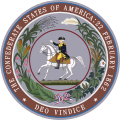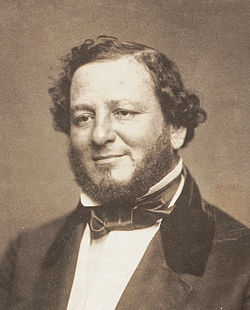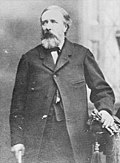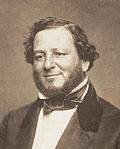History and role
The Confederate States Department of State was created on February 21, 1861. A secretary of state was to be appointed by the president and approved by the Confederate Congress to direct the Department of State. The secretary oversaw the issuing of passports, which were required for foreign travel and domestic travel between Confederate states. The secretary of state was required to preserve all bills passed by the Confederate Congress and publish new bills in at least three separate newspapers in the Confederacy and distribute each bill to the executive departments of each state. The secretary also authenticated records with a seal of the department and was in possession of the Seal of the Confederate States. Additional roles of the secretary included countersigning commissions and pardons, recording copies of presidential proclamations, taking applications for letters of marque from captains of private vessels, managing copyright records, and recording property that was destroyed by the United States.
The secretary of state directed representatives to discuss disagreements with the United States in Washington, D.C., including requesting for Forts Sumter, Pickens, and Taylor to be evacuated of US troops.
One of the primary role's of the secretary of state was to oversee Confederate representatives abroad and interact with foreign countries as directed by the President. Representatives of the Confederacy negotiated with these foreign countries for recognition of the Confederate government, secured funding, and promoted economic relations. The secretary directed these representatives despite the delay in receiving reports from their assigned countries due to the Union blockade. Assigned countries and representatives included Great Britain (William L. Yancey, then James M. Mason), France (Yancey, then Ambrose Dudley Mann), Belgium (Mann), Spain (Pierre Adolphe Rost). Lucius Quintus Cincinnatus Lamar served as the Special Confederate Commissioner to Russia, while Bishop Patrick Neeson Lynch was granted an audience with Pope Pius IX. The secretary also directed agents to recruit Polish exiles for service in the Confederate States Army, while agents such as Henry Hotze promoted information favorable to the Confederacy in foreign newspapers. The Department of State attempted to obtain supplies from Mexico and carried out assignments in Canada, Cuba, Bermuda, The Bahamas.
The Confederate States Department of State was small and consisted of no more than seven employees, including the secretary, an assistant secretary, researchers, and clerks. On February 27, 1861, the secretary of state was authorized to appoint an assistant secretary of state. William M. Browne served as the first assistant secretary, and after his resignation, the assistant secretary position was filled by successive chief clerks. The secretary of state was paid $6,000 per year, while the assistant secretary of state was paid $3,000 annually.
After the capital of the Confederacy was moved from Montgomery to Richmond in May 1861, the secretary of state's office was located on second floor of the former U.S. Customhouse.
In April 1865, official documents and records relating to the secretary of state and Department of State were transferred to Charlotte, North Carolina. After the collapse of the Confederate government, these records were eventually kept in Hamilton, Ontario, prior to being purchased by the United States Department of the Treasury for $75,000. These records (which included dispatches and correspondences with foreign governments), were used in processing wartime claims. [16] The collection was referred to as the Pickett Papers, after John T. Pickett, a former Confederate agent who sold the collection in 1872. By 1910, the records were transferred to the Library of Congress.
Secretaries of state
Robert Toombs of Georgia became the first Confederate States secretary of state on February 27, 1861. Toombs had previously served as a United States representative and senator. L. Q. Washington, who began serving as a clerk under Toombs, described him as a gifted orator but his "delivery was marred by his vehemence, impetuosity, and consequent imperfect enunciation." Toombs did not spend much time in his office and Washington felt he favored military service over office work. On July 19, 1861, Toombs was commissioned as a brigadier general in the Confederate States Army and resigned as secretary of state five days later. Toombs also served as a delegate to the Provisional Congress of the Confederate States.
Robert M. T. Hunter of Virginia became the second Confederate States secretary of state on July 25, 1861. Hunter was educated as a lawyer at the University of Virginia and had served as a U.S. Representative, Senator, and was the Speaker of the United States House of Representatives from 1839 to 1841. Washington (who by November 1861 was the chief clerk for the secretary of state), described Hunter as being more scholarly and having a greater grasp of public affairs than Toombs. Hunter served as a delegate to the Provisional Congress of the Confederate States, and after being elected as a Confederate States senator, resigned as secretary of state on February 18, 1862.
After Hunter resigned, William M. Browne was promoted to acting secretary of state from assistant secretary of state on February 19, 1862. Browne had previously served as acting secretary of state as early as March 6, 1861, while Toombs was away from his office on business. Browne was originally from County Mayo in Ireland and was criticized for not being a native Southerner. Browne could speak multiple languages and assisted in establishing trade for copper, lead, and military supplies with Mexico. Browne again resumed the role of assistant secretary of state after a permanent replacement was appointed.
On March 25, 1862, Judah P. Benjamin a former U.S. Senator from Louisiana, was appointed as the third Confederate States secretary of state. Benjamin had previously served as the Confederate States Attorney General and Confederate States Secretary of War. Washington, who served as assistant secretary of state after Browne resigned to serve as Davis' aide-de-camp and colonel of cavalry, described Benjamin as an efficient worker who spoke with a "rare eloquence." Benjamin spoke and read multiple languages and frequently counseled with Davis on governmental affairs. Benjamin served as secretary of state until the collapse of the Confederacy.
This page is based on this
Wikipedia article Text is available under the
CC BY-SA 4.0 license; additional terms may apply.
Images, videos and audio are available under their respective licenses.






